Light-based technologies offer the military significant advantages in sensing, communications and even weaponry.
The US Army has touted its ownership of the night – and the implied advantage therein. But times have changed.
“Nowadays, that’s not so much so because there’s a vast proliferation of night-vision technologies throughout the world,” said Gregory J. Quarles, chairman of the public policy committee of The Optical Society.
The 2012 report Harnessing Light for America’s Technological Future from the National Research Council outlines tomorrow’s military needs, noting that photonics and optics could play key roles in sensing, communications and weapons. These areas provide a guide for the intersection of photonics and defense over the next decade.
We see you
With regard to sensors, the military’s goal is to detect, recognize, identify and determine intent at greater distances more rapidly and with greater certainty. That requires exploiting more of the optical spectrum.
“The purpose is to utilize all information you can get out of a scene,” said Cees Draijer, senior program manager for defense, security and infrared at digital imaging solutions supplier Teledyne Dalsa of Waterloo, Ontario, Canada.

Multispectral imaging, as in this picture of Kenya’s Nzoia River basin captured by a Teledyne Dalsa multispectral sensor, can reveal information other sensors can’t, a key
reason why the technique is being pursued by the military.
Capturing multiple spectral bands simultaneously presents distinct challenges. For instance, thermal imaging at a wavelength of 8 µm uses germanium lenses, while visible at 500 nm uses optically clear glass. Beyond that, there is the issue of merging separate images into one, which requires scaling, correcting and matching image data. Successfully doing this locally involves getting more intelligence in the camera itself, Draijer said.
Increasing detector intelligence can pay other dividends. One example comes from the Fairfax, Va.-based defense contractor General Dynamics Advanced Information Systems. Its technology can remove scintillation in an image resulting from heat or detector jitter. The technique uses the pixels in each live or recorded frame that are distortion-free.
“Algorithmically, you can use those untouched pixels in order to remove most of the effects,” said Gregory J. Catherine, director of technology integration at General Dynamics.
A long-term goal is to use imaging and other information for activity-based intelligence, Catherine said. This may be done in systems carried by a soldier, placing a premium on lightweight, low-power and low-cost solutions.
Advances should make IR sensors more capable while meeting these needs, which is something that Sofradir of Châtenay-Malabry, France, is working on. The company is one of only two in the world that offer all four cooled IR sensor technologies, said marketing manager Marc Larive.
Cooled detectors are chilled to 77 to 90 K, with the lower temperature that of liquid nitrogen. Sofradir’s latest mercury cadmium telluride sensor innovation raises that figure considerably.
“With the new technology, you can operate at 150 K,” Larive said.
The temperature increase cuts power consumption by more than half. This means that smaller batteries are needed, reducing weight and size – which is important, given the military’s need for portable equipment.
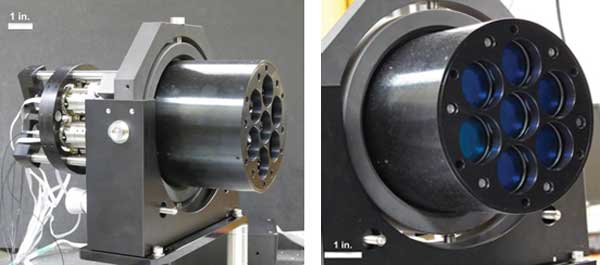
Optically combining inexpensive lasers could yield a weapon, a possibility being actively researched by the US Department of Defense.
Another IR advance comes from Ulis of Veurey-Voroize, France, a subsidiary of Sofradir. The company makes uncooled IR detectors that operate by monitoring temperature changes in amorphous silicon.
This approach can be both low-cost and lightweight. Compared with cooled sensors, the drawbacks are sensitivity and refresh rate. However, the technology has exhibited military-grade performance, said technical director Jean-Luc Tissot.
Gigapixel cameras and chemical sensors
As for optical sensors, the future may hold inexpensive multigigapixel cameras. A 2012 Nature paper by researchers from Duke University, the University of Arizona and elsewhere describes a demonstration system – constructed of 98 microcameras, each equipped with a 14-megapixel sensor – that captured a gigapixel three times a minute.

A gigapixel camera constructed out of many megapixel cameras could enable very high resolution imaging for military and other applications. Diagram by Hui Son and images by David Kittle.
David J. Brady, a Duke electrical engineering professor and project leader, noted that the researchers didn’t originally know how to build the optical components. They overcame this challenge by constructing a ball that measures 30 cm.
“We’ve solved the optical problem, but now the electronics is the main problem – figuring out ways to make the electronics energy efficient and really shrink its size,” Brady said.
In five or so years, there could be handheld gigapixel cameras, he predicted. The capability to see more is of great interest to the military, which helped fund the group’s work.
Other investigators have demonstrated photonics-based chemical sensors. A group from the US Army Research Laboratory in Adelphi, Md., exploited the fact that the absorption of light generates sound waves. With this photoacoustic effect and multiple lasers, the team chemically fingerprinted and identified five nerve agent mimics, according to a 2012 Optics Letters paper. A field-capable system would ideally need six or so mid-IR quantum cascade lasers in a milk carton-size device, the researchers say.
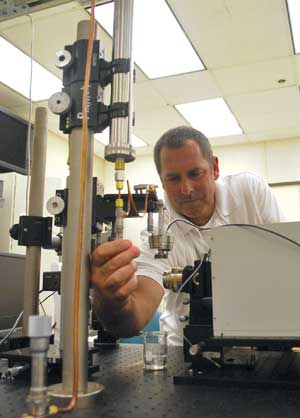
Dr. Kristan Gurton, an experimental physicist in the Battlefield Environmental Div., Computational and Information Sciences Directorate, US Army Research Laboratory, conducts experiments.
Another photonics-based chemical sensor comes from a group led by Ilana Bar, a physics professor at Israel’s Ben-Gurion University of the Negev. The team built a compact Raman spectrometer using a regular green laser pointer for excitation. Measurement of both liquids and solids takes only a few seconds, with explosive detection a possible application, according to a presentation at the 2012 Frontiers in Optics meeting.
The system could be small, inexpensive and offer important capabilities, Bar said. “We also have a possibility to make an X-Y translation of the sample. This allows us to find the position of individual particles and also to do chemical imaging.”
Years ago, Battelle, a Columbus, Ohio-based research and development organization, concluded that the operating cost of traditional biological sensing and identification using wet chemistry was too high. New methods not requiring consumables were needed, said Philip Schofield, manager of sensors and communications systems.
The development of light sources has helped enable optical solutions. Raman spectroscopy methods, for example, can now be 40 lb or less. In contrast, an older wet chemical system might come in at hundreds of pounds, he said.
Safe, sure communication
Of course, imaging and sensor data would preferably be shared in real time. Thanks to high-definition video and other high-content streams, that data load is growing.
Fortunately, photonics can help. Free-space communications could link points together at high data rates. What is needed are powerful enough sources, sufficiently sensitive detectors, and mechanisms to maintain alignment between the two. Achieving these attributes in a small, rugged package is a challenge.
However, another approach is to use photonic devices for carrier modulation. That can up the capacity of millimeter-wave radio signals considerably, Schofield said. A commercial-grade 1550-nm laser overdriven by a modulator can generate bands carrying about 10 Gb of data. This hybrid approach brings benefits.
“It’s very, very difficult in the radio-frequency domain, in terms of efficiently generating a millimeter-wave carrier signal. However, efficiency at those frequencies is relatively easy in the optical domain,” Schofield said.
In the future, making sure that what is sent is secure is likely to involve quantum communications. Done with photons, this approach theoretically is immune to eavesdropping.
Commercial systems that distribute encryption keys are available today. One such system is offered by ID Quantique of Geneva. These products use an attenuated laser to create a pseudo-single-photon source. Current technology works in standard telecom fiber for perhaps 100 km, enough for use within cities but not across a continent. The company is trying to increase that distance, said Kelly Richdale, vice president of network encryption.
“The ultimate goal is quantum repeaters, where you ‘amplify,’ or teleport, the signal without losing the quantum coherence,” she said. “But that’s certainly more than a couple of years out, probably between five and 10.”
Donald Hayford, senior research leader at Battelle, shares that assessment. Battelle is teaming up with ID Quantique to extend the range of the current technology by building a tamper-resistant, cryptographically secure trusted node in which encryption keys will come out of and then go back into the quantum realm.
It actually may be easier to debut and prove the new technology commercially and then allow it to find applications in defense. Improved photonics could help.
“Better detectors are always an issue. Single-photon sources are always an issue,” Hayford said.
On the small screen
Communication isn’t only between machines. People, too, are involved, and here photonic innovations can help.
For instance, Zebra Imaging of Austin, Texas, makes holographic imagers. The company’s static film holography has been used in Iraq and Afghanistan to provide full-parallax 3-D visualization of urban and mountainous terrain. Zebra also has a table-shaped device currently being evaluated by the military.
“That table is actually modulating light up above the plane of the glass so the information in the hologram is dynamically updatable,” said Rick Black, director of defense and intelligence programs.
This is done using thousands of light modulators. The next generation will create crisper and taller images, Black said.
MicroOLED of Grenoble, France, is commercializing organic LED microdisplays for near-eye use. In 2012, the company announced a 5.4-megapixel single-color microdisplay for helmet mounting and defense applications, said CEO Eric Marcellin-Dibon.
The primary use will be night vision, but other versions of the chip could display additional information; e.g., making the pixels white and red at a ratio of 3:1 would allow the white to carry night-vision information, while the red would handle thermal IR imagery. The concept can be extended, with cyan replacing a third of the white pixels to handle text and graphics in a merging of night vision, thermal imaging and other information.
“Basically, the fusion is made at the display level,” Marcellin-Dibon said.
Long term, there is a need to increase display luminance while cutting power consumption, he added. Any solution must do so intelligently because displays will be used day and night.
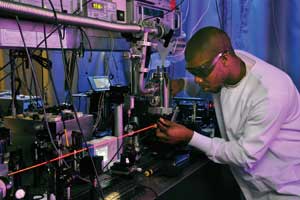
A US Army Research Laboratory student, among those who visit the lab for a summer internship, works in the high-energy solid-state laser laboratory. The research here is devoted to exploring the limits of scaling lasers to high energy for applications of directed-energy weapons.
Weaponry to burn
As for weaponry, lasers have attracted attention for both defense and offense. For success, they must get enough photons on target in a cost-effective manner. Two weapon-related development programs are currently being run by DARPA, which funds high-risk, high-reward projects.
The first program is the high-energy liquid laser area defense system and is based on a diode-pumped, liquid-cooled solid-state laser. The goal is to produce a final output power of 150 kW from a 750-kg package. The program is in the final stages of development of a demonstration weapon, with field testing to begin by the middle of this year.
Dealing with generated heat is a challenge for any high-power laser system, but DARPA has solved this through advanced cooling techniques, said program manager Rich Bagnell. “HELLADS [DARPA’s portable High Energy Liquid Laser Area Defense System] will scale up its thermal management approach to maintain optical and thermal control. Because we’ve constructed in a building-block approach, this scaling has been thoroughly engineered.”
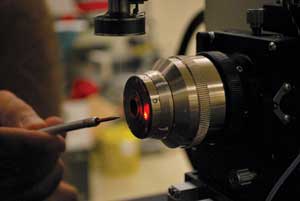
This laser is used to optically “heat” very small particles.
The second program, Excalibur, aims to produce a base technology but not a weapon. The goal is to create systems that are a tenth the size and weight of existing high-power chemical lasers. This will be done with phased array technologies, allowing lower-power electrically driven lasers to optically gang up.
Currently, the plan is to use dozens of kilowatt-size fiber lasers as individual array elements, said program manager Joseph Mangano. Such arrays could offer four times the efficiency of other approaches in terms of delivering input power to a target.
Besides lasers, Excalibur will employ other photonic technologies, he said. “Each element in the phased array will include an integrated tip-tilt adaptive optics system that will allow for correction of beam distortions created by the optics of the phased array as well as atmospheric turbulence.”
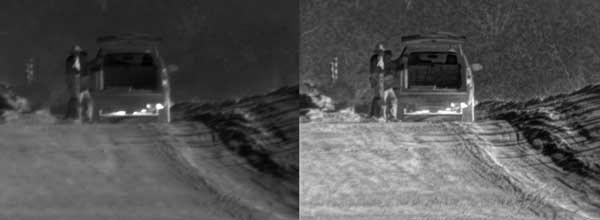
Technology can sharpen a live or recorded original image (left) by removing turbulence from pixels (right), allowing the military to detect, recognize and identify people and objects at greater distances. These infrared images were taken during testing in the Arizona desert.
In the end, all sensor, communications and weapon technologies face some fundamental constraints. Cost is one, although the picture may change when everything is accounted for. More expensive photonics can cut overall mission costs – for example, by allowing an unmanned vehicle to take the place of a more expensive manned aircraft.
However, other restrictions are also very important, said Gary Wood, chief of the Electro-Optics & Photonics Division at the US Army Research Laboratory. Any new technology often must be carried by a system that isn’t changing rapidly and has some fixed limits, he said; namely, an infantry soldier.
“That platform, being human, is very sensitive to size, weight and power,” he said.